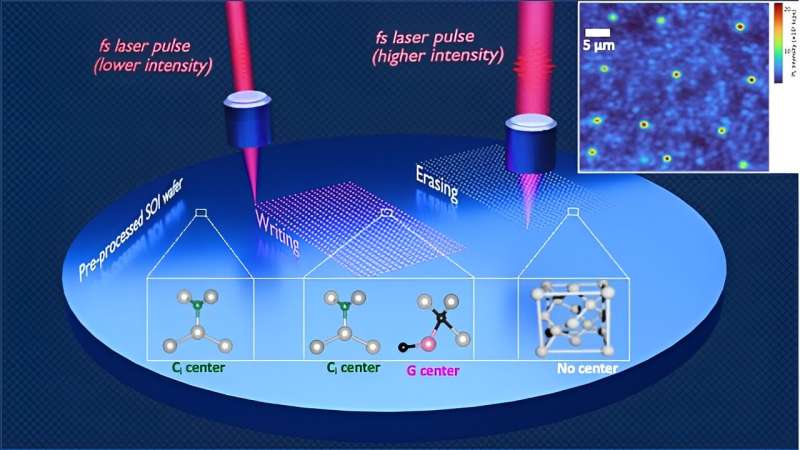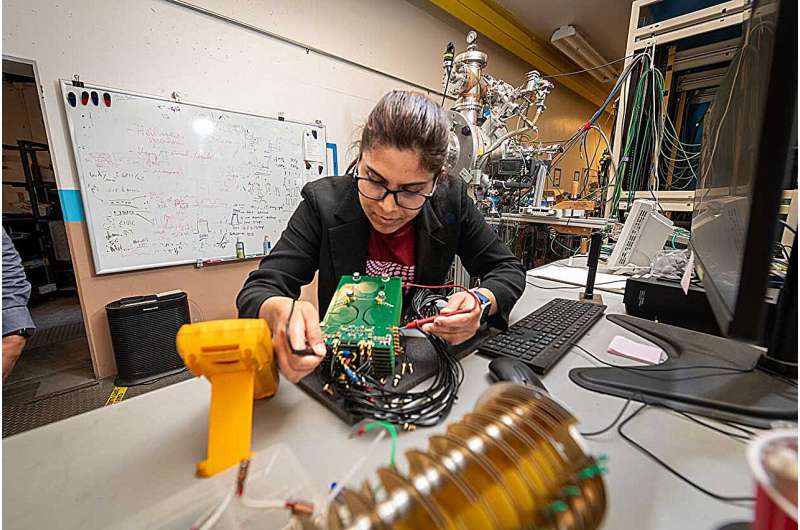
An artistic depiction of a new method for creating high-quality color centers (qubits) in silicon at specific locations using ultrafast laser pulses (femtosecond or one quadrillionth of a second). The top right inset shows an optical signal (photoluminescence) observed experimentally from the qubits, with their structures shown at the bottom. Credit: Kaushalya Jhuria/Berkeley Lab
Quantum computers have the potential to solve complex problems related to human health, drug discovery and artificial intelligence millions of times faster than some of the world’s fastest supercomputers. A network of quantum computers could advance these discoveries even faster. But before that can happen, the computing industry will need a reliable way to connect billions of qubits – or quantum bits – with atomic precision.
However, connecting qubits has proven to be a challenge for the research community. Some methods form qubits by placing an entire silicon wafer in a rapid annealing oven at very high temperatures.
With these methods, qubits form randomly from defects (also called color centers or quantum emitters) in the silicon crystal lattice. And without knowing exactly where qubits are located in a material, a quantum computer made up of connected qubits will be difficult to achieve.
But now it may soon be possible to connect qubits. A research team led by the Lawrence Berkeley National Laboratory (Berkeley Lab) claims to be the first to use a femtosecond laser to create and “annihilate” qubits on demand and with precision, by doping silicon with hydrogen.
This advance could allow quantum computers using programmable optical qubits or “spin photon qubits” to connect quantum nodes on a remote network. It could also advance a quantum internet that would not only be more secure, but could also transmit more data than current fiber optic information technologies.
“To create a scalable quantum architecture or network, we need qubits that can reliably form on demand, at desired locations, so we know where the qubit is in a material. And that’s why our approach is essential,” said Kaushalya Jhuria. , postdoctoral researcher in the ATAP (Accelerator Technology & Applied Physics) division of Berkeley Lab. She is the first author of a new study describing the technique in the journal Natural communications.
“Because once we know where a specific qubit is, we can determine how to connect that qubit with other components in the system and create a quantum network.”
“This could open a potential new avenue for industry to overcome the challenges of qubit manufacturing and quality control,” said principal investigator Thomas Schenkel, head of the Fusion Science and Beam Technology program. ions from the ATAP division of Berkeley Laboratory. His group will welcome the first cohort of students from the University of Hawaii in June, where students will be immersed in the science and technology of color centers/qubits.
Formation of silicon qubits with programmable control
The new method uses a gas environment to form programmable defects called “color centers” in silicon. These color centers are candidates for special telecommunications qubits or “spin photon qubits”. The method also uses an ultrafast femtosecond laser to anneal silicon with pinpoint precision precisely where these qubits should form. A femtosecond laser delivers very short pulses of energy in a quadrillionth of a second to a focused target the size of a dust grain.
Spin photon qubits emit photons that can carry information encoded in electron spin over long distances: ideal properties to support a secure quantum network. Qubits are the smallest components of a quantum information system that encode data in three different states: 1, 0, or a superposition between 1 and 0.

Kaushalya Jhuria in the lab testing the electronics of the experimental setup used to make silicon qubits. Credit: Thor Swift/Berkeley Lab
With the help of Boubacar Kanté, a researcher in Berkeley Lab’s Division of Materials Sciences and professor of electrical engineering and computer science (EECS) at UC Berkeley, the team used a near-infrared detector to characterize the resulting color centers by probing their optical (photoluminescence) signals.
What they discovered surprised them: a quantum emitter called CI center. Due to its simple structure, room temperature stability, and promising spin properties, CI center is an interesting spin photon qubit candidate that emits photons in the telecommunications band. “We knew from the literature that CI can be formed in silicon, but we did not expect to create this new spin photon qubit candidate with our approach,” Jhuria said.
Researchers learned that treating silicon with a low-intensity femtosecond laser in the presence of hydrogen helped create CI color centers. Further experiments showed that increasing the laser intensity can increase the mobility of hydrogen, which passivates unwanted color centers without damaging the silicon lattice, Schenkel explained.
A theoretical analysis by Liang Tan, a scientist at Berkeley Lab’s Molecular Foundry, shows that the luminosity of CI The color center is increased by several orders of magnitude in the presence of hydrogen, confirming their observations from laboratory experiments.
“Femtosecond laser pulses can expel hydrogen atoms or bring them back, enabling the programmable formation of desired optical qubits at precise locations,” Jhuria said.
The team plans to use this technique to integrate optical qubits into quantum devices such as reflective cavities and waveguides, and to discover new spin photon qubit candidates with optimized properties for selected applications.
“Now that we can reliably create color centers, we want different qubits to communicate with each other – which is an embodiment of quantum entanglement – and see which ones work best. This is just the beginning,” Jhuria said.
“The ability to form qubits at programmable locations in a material like silicon, available at scale, is an exciting step toward practical quantum networking and computing,” said Cameron Geddes, director of the ATAP division. .
More information:
K. Jhuria et al, Formation of programmable quantum emitters in silicon, Natural communications (2024). DOI: 10.1038/s41467-024-48714-2
Provided by Lawrence Berkeley National Laboratory
Quote: A new technique could help build the quantum computers of the future (June 11, 2024) retrieved June 12, 2024 from https://phys.org/news/2024-06-technique-quantum-future.html
This document is subject to copyright. Except for fair use for private study or research purposes, no part may be reproduced without written permission. The content is provided for information only.